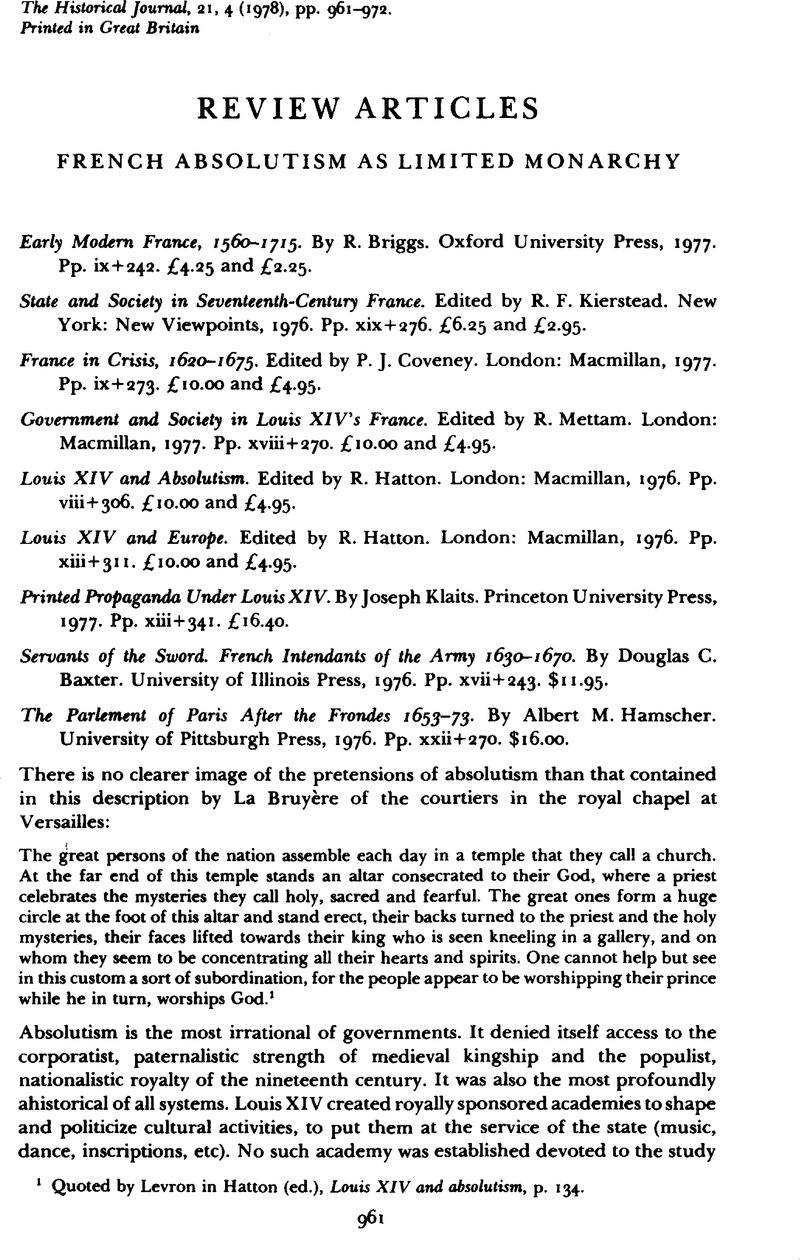Published online by Cambridge University Press: 11 February 2009

1 Quoted by Levron, in Hatton, (ed.), Louis XIV and absolutism, p. 134.Google Scholar
2 Hatton, (ed.), Louis XIV and absolutism, p. 18.Google Scholar
3 Ibid. p. 211.
4 Cf. Loirette, F., ‘The defence of the allodium in seventeenth-century Agenais’Google Scholar, in the book under review edited by Kierstead.
5 Mousnier, R., La plume, la faucille et le marteau (Paris, 1970), p. 11.Google Scholar
6 This book is in the Opus series, an introduction for undergraduates, lacking critical apparatus but with an excellent bibliographical essay.
7 Shennan, J. H., Government and society in France, 1461–1661 (London, 1969)Google Scholar; Wallace-Hadrill, J. M. and McManners, J. (eds.), France: government and society (London, 1959).Google Scholar
8 E.g. ‘The grand Condé may have been an incomparably better general than his father; as a person and as a politician he was just as impossible’; the crushing burdens imposed by the economic recession and by government made ‘nobles, artisans and peasants increasingly jumpy’.
9 Unlike the other books aimed at undergraduates and despite the claims of the dustjacket, this book contains no bibliography, no glossary, and no maps, though Mettam pays considerable attention to regional differences.
10 Cf. the article by N. Temple in Kierstead, , State and society.Google Scholar
11 Cf. the Crown's successful war of attrition against the parlement of Rennes recorded by J. C. Rule in Kierstead, , State and Society.Google Scholar
12 Cf. Kossmann, 's dictum ‘Absolutism was the first political system able to profit from the printing press; it seized its chance’Google Scholar (Hatton, , Louts XIV and absolutism, p. 4).Google Scholar
13 All three contain useful and succinct glossaries of technical terms. Kierstead has a brief bibliographical essay, Coveney a longer bibliography good on works in English, but idiosyncratic in its selection of French titles. Hatton has two-line biographies of all those mentioned in the text, but infuriatingly has no index.
14 Cf. the text at n. 4.
15 Hatton has also edited a companion volume, Louis XIV and Europe, which is similar in its mixture of translated and freshly commissioned articles. Her own contribution on Louis XIV and his fellow monarchs is outstanding, as is Tapié's essay on the king's methods, but again important issues are ignored and peripheral ones included.
16 Porschnev, B., Les soulèvements populaires en France de 1623 à 1648 (Paris, 1963)Google Scholar. This is a translation of a work which originally appeared in Russian in 1948.
17 Mousnier, R., Fureurs paysans (Paris, 1967)Google Scholar; an English translation under the title Peasant uprisings in seventeenth-century France, Russia and China appeared in 1971.
18 E.g. Pillorget, R., ‘Mouvements insurrectionnels ruraux (Provence, 1596–1715)’, Actes du 92e Congrès National des Sociétés Savantes (1970), pp. 360–82Google Scholar; Lebrun, F., ‘Soulèvements populaires à Angers’, Actes du 90e Congrès National des Sociétés Savantes (1965), pp. 120–39Google Scholar; or the final section of Gaillard, M., ‘Recherches sur les soulèvements populaires en Basse-Normandie, 1620–40’, Cahiers des Annales de Normandie, III (1963), 33–122.Google Scholar
19 The contrast is taken from Stoye, J., Europe unfolding (London, 1969), pp. 80–7.Google Scholar
20 Hamscher, , The parlement of Paris, p. 42.Google Scholar
21 In Hatton, , Louis XIV and absolutism.Google Scholar
22 Mousnier, , Peasant uprisingsGoogle Scholar, passim; Mousnier, , La Plume, pp. 265–386.Google Scholar
23 Bercé, Y., ‘La noblesse rurale du Sud-ouest de la France sous Louis XIII’, Annales de Midi, 1964, pp. 43–59.Google Scholar
24 Lassaigne, J. D., Les Assemblées de la noblesse de France aux XVIIe et XVIIIe siècles (Paris, 1962), pp. 5–28.Google Scholar
25 Mousnier, R., Labatut, J.-P. and Durand, Y., Deux cahiers de la noblesse pour les Etats Generaux de 1649–51 (Paris, 1965), pp. 31–6.Google Scholar
26 Shennan, J. H., Government and society, pp. 42–3.Google Scholar
27 The second estate was represented exclusively by the sword. The third estate representatives were overwhelmingly drawn from the officials, many of them nobility of the robe (Hatton, , Louis XIV and absolutism, pp. 38–9).Google Scholar
28 Cf. James, M. E., ‘Obedience and dissent in Henrician England’, Past and Present, no. 48 (1970)CrossRefGoogle Scholar; Elton, G. R., Reform and Reformation (Cambridge, 1977), pp. 260–71.Google Scholar
29 Roche, D., ‘Revenus des princes de Condé au début de XVIIIe siècle’, Revue d'Histoire Moderne et Contemporaine, XIV (1967), 218–43Google Scholar; Mougel, F., ‘La fortune des Princes de Bourbon-Conti’, Revue d'Histoire Moderne et Contemporaine, XIV (1967), 30–49.Google Scholar
30 Forster, R., The house of Saulx-Tavannes (Princeton, 1971), passim.Google Scholar
31 Quoted by Klaits, Printed propaganda.
32 Levron, 's article, an extract from his book Les courtisans (Paris, 1960)Google Scholar, is in Hatton, , Louis XIV and absolutism.Google Scholar
33 See the article by Rule in Kierstead, , State and society.Google Scholar
34 See the article by Temple in Kierstead, , State and societyGoogle Scholar, also Briggs, , Early modern France, pp. 47–54.Google Scholar
35 See the article by Bernard, in Kierstead, , State and society.Google Scholar